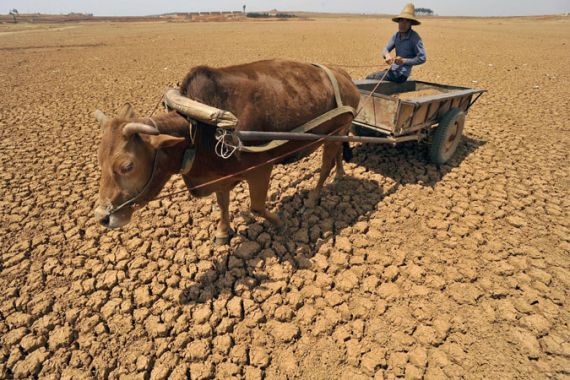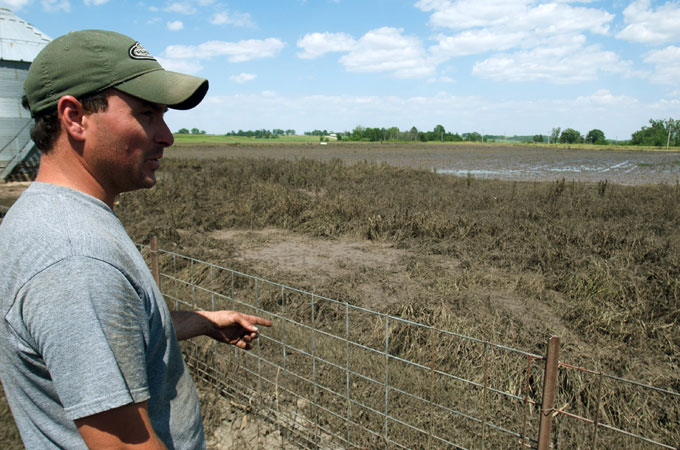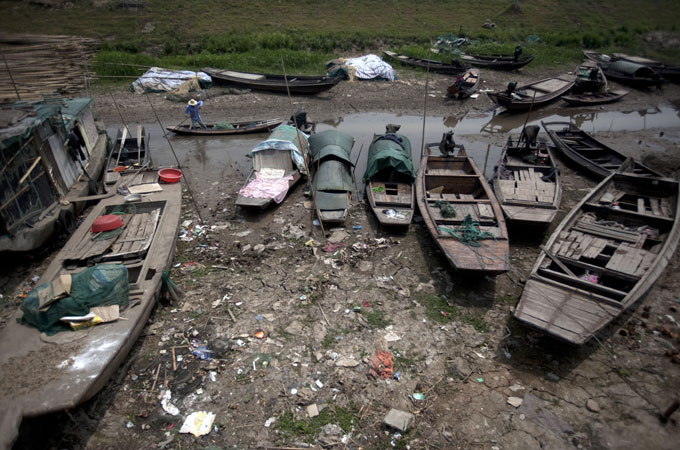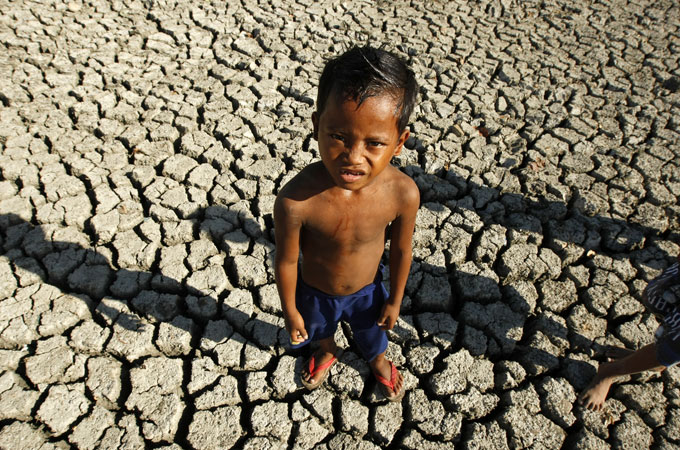The decline of agriculture?
Climate change induced extreme weather events and shifting weather patterns are challenging farmer’s ability to feed us.

 |
| Flooding ravaged farms in the midwest United States this June, causing many crops to be lost [GALLO/GETTY] |
Wendy Johnston with Oakwyn Farms in Athens, West Virginia, is deeply concerned about how shifting weather patterns are impacting farmers’ ability to feed the global population.
“This year we’re off to a slow start,” Johnston, who farms 40 hectares, told Al Jazeera. “Last year in April we were able to plant, but this year we even had rain, cold and snow a few days in April. The weather has become very unpredictable, and that’s the real problem.”
Keep reading
list of 4 itemsLost Futures
Photos: Greek valley that became a lake stirs drought debate
Botswana threatens to send 20,000 elephants to Germany
Climate change is making farming more difficult for her, and she wonders how much worse things will become.
On March 31, The Food and Agriculture Organisation (FAO) warned of “potentially catastrophic” impacts on food production from slow-onset climate changes that are expected to increasingly hit the developing world.
The report filed with the United Nations Framework Convention on Climate Change, warned that food production systems and the ecosystems they depend on are highly sensitive to climate variability and change.
Changes in temperature, precipitation, and related outbreaks of pest and diseases could reduce production, the report said. Those particularly vulnerable are poor people in countries that rely on food imports, although climate change events are already driving up food costs around the globe, including in developed countries.
April broke many weather-related monthly records in the US, including 292 tornadoes and 5,400 extreme weather events, which combined to cause 337 deaths.
The US National Climatic Data Center announced in June that April’s weather extremes were “unprecedented” and “never before” seen in a single month. The center also noted drought across the southern plains, wildfires in the southwest, and record floods along the Mississippi River.
 |
| China has been wracked by both severe drought and severe flooding this year, both resulting from climate change induced shifting weather patterns [GALLO/GETTY] |
“Severe weather events around the world will increase, even parts of the globe that don’t normally see extreme weather events,” said Steff Gaulter, Al Jazeera’s senior weather presenter. “Those parts of the world that already struggle with water shortages will find matters worsening, including Australia, Mexico, the southwest United States, and parts of Africa.”
Gaulter agrees with the FAO that poorer countries are likely to be the worst affected because they have less resources to cope with disasters.
“With worsening water-shortages, there will be more crop-failures, which means an increase in malnutrition,” she added. “There is also likely to be an increase in disease as people drink water that is unsuitable for consumption. All of this is an added expense that will be particularly punishing for poorer regions to endure, particularly Sub-Saharan Africa.”
Approximately 300 million people in Sub-Saharan Africa currently lack access to clean drinking water.
“It is also estimated that by 2020, an additional 75 to 250 million people there will also face water shortages,” said Gaulter. “That’s in less than ten years.”
Soil in peril
Kevin Trenberth, a senior scientist at the US National Centre for Atmospheric Research (NCAR) in Boulder, Colorado, believes it is time to emphasize the link between extreme weather and the global climate in which it develops.
“The environment in which all storms form has changed owing to human activities. In particular, it is warmer and more moist than it was 30 or 40 years ago,” Dr Trenberth said.
“We have this extra water vapour lurking around waiting for storms to develop and then there is more moisture as well as heat that is available for these storms [to form]. The models suggest it is going to get drier in the subtropics, wetter in the monsoon trough and wetter at higher latitudes. This is the pattern we’re already seeing.”
Climate change has generated shifting weather patterns and extreme weather events that make it more difficult for farmers to feed us. A reliance upon non-renewable energy is also a factor in impending food crises.
Professor Michael Bomford, a research scientist at Kentucky State University and a fellow of the Post Carbon Institute, is concerned about how our dependence on oil to feed ourselves is leading to soil depletion and degradation, as well as increasing prices.
“The farm is a very small proportion of the economy in the US and other developed countries, but it has a disproportionate impact on global change,” Professor Bomford, who has a Master’s of Pest Management and a PhD in Plant and Soil Sciences, told Al Jazeera. “Clearing land for farming releases carbon into the atmosphere and that contributes to climate change. Then by farming it, using cultivation causes soil to be lost in wind and erosion, and that topsoil took thousands of years to form. One extreme weather event can cause us to lose thousands of years of soil.”
Modern farming impacts soil by the use of nitrogen fertilizers, which are energy intensive to produce and which deplete carbon in the soil.
“This erodes the soil’s ability to hold nutrients, and starts a positive feedback loop,” added Professor Bomford. “A lot of our soils now rely on irrigation rather than rainfall, which depletes groundwater reserves, and these have huge impacts on the soil.”
William Ryerson, founder and president of the Population Media Center and president of the Population Institute, is also very concerned about fertilizers’ impact on soil. He has questioned how, in the long run, this will impact agriculture.
“The world’s agricultural systems rely substantially on increasing use of fertilizers,” Ryerson told Al Jazeera. “But now, the world’s farmers are witnessing signs of a declining response curve, where the use of additional fertilizer yields little additional food product. At the same time, fertilizers and intensive cropping lower the quality of soil. These factors will more and more limit the possibilities of raising food production substantially and will, at a minimum, boost relative food prices and resulting hunger for many.”
Carbon stored in soil allows the soil to hold nutrients and water, and losing soil contributes to climate change. Bomford is worried about other contributing factors to climate change borne from the use of chemical fertilizers.
“Agriculture produces methane and nitrous oxides, like with animal agriculture that contributes to climate change, and these have a much greater effect on climate change than CO2,” he said. “Ocean dead zones are associated with fertilizers since phosphorus and nitrogen applied to our farms runs down rivers into the oceans creating algal blooms, and that pulls oxygen out of the water and we end up with vast dead zones from lack of oxygen for marine life.”
In June, scientists from the University of Michigan predicted a record Gulf of Mexico dead zone due in large part to the flooding of the Mississippi River. The dead zone is forecast to be between 22,014 and 24,400 square kilometers, an area roughly the size of the US state of New Hampshire.
This estimate dramatically surpasses the 15,539-square-kilometer average of the past five years, as well as the current record, set in 2002, of 21,755 square kilometers.
“Every spring, around this time, we see these vast dead zones forming at the mouth of the Mississippi and other rivers,” said Bomford. “Surface waters carry valuable sediments from our soil into the water and that causes dirty and cloudy water. Agriculture plays a disproportionate role in contributing to the decline of the oceans.”
Shifting towards crisis
Ryerson warns of these trends causing massive food shortages in the future.
“Because of industrialization leading to loss of agricultural land, population growth, and the demand for more meat instead of grain as incomes rise, China is projected to need to import 240 million tons of food annually by the year 2030,” he said.
Projections also show that India, currently a food exporter, will need to import 30 million tons a year by 2030.
“Yet, total world agricultural trade is currently just 200 million tons of grain or grain equivalent, and that amount is decreasing as the exporting countries consume more and more of their own food products,” said Ryerson. “Accordingly, the increasing demand for food imports by growing economies like China’s will almost certainly drive up the price of food over the next 30 years, virtually ensuring that more people elsewhere will suffer from starvation.”
Gaulter warned that shifting weather patterns lead to lack of drinking water in many areas of the globe.
 |
| Climate change induced drought is becoming more common around the world [EPA] |
“It’s also worth mentioning that as the world heats up, glaciers and snow cover are also expected to decline,” she said, “This will reduce water availability in countries supplied by melt water, so lack of drinking water will be a problem in parts of the globe such as South America and Asia, even though the region may not technically be in a drought.”
She cited Australia as a place where the increasing drought effects of climate change are already being seen.
“Australia is already getting hotter and drier. By 2030, there are forecast to be 20 per cent more droughts, and it’s estimated that by 2050, the annual flow into the Murray-Darling basin will fall by up to a quarter. This basin takes up much of southeastern Australia and provides 85 per cent of the water that is used for irrigation nationally.”
Gaulter said counties like India, Bangladesh, and Myanmar are going to be heavily impacted by increasing floods, and other poor countries will be particularly heavily affected. “Not necessarily because they’ll see more of them [floods], but because they have less resources to call on in times of emergency. Following a devastating flood we often see outbreak of disease, such as diarrohea and dysentery, due to the lack of clean drinking water.”
Winds of change
Johnston believes people who do not grow their own food can’t realize when certain crops should or should not be available.
“Things people expect at certain times are no longer there much of the time now,” she said, “There isn’t squash available now like there used to be. Usually in June [there are] lots of lettuce greens peas and squashes, but because of changing weather patterns the squash will now be late, and the heat caused us to replant the greens and lettuces, which will now be late as well.”
Chandler Goule, vice president of government relations for the National Farmers Union in the US, is a long-time supporter of the science behind climate change. He believes the weather changes are from “impacts caused by humans.”
“As we continue to see increasing weather disasters in the US and around the world, we will see increasing food costs, hungry people, and this will cause the consumer to spend more of their income on food,” Goule told Al Jazeera.
Farmers like Johnston are acutely in touch with the shifting weather patterns due to climate change.
“We really don’t have spring anymore,” she said of where she lives. “In May, it rained a lot and was cold, but the week before Memorial Day [the last Monday of May], it was 11 C and raining, and the next week it was 33 C.”
Johnston explained that an abrupt temperature shift like this is extreme for agriculture, which cannot survive huge, sudden shifts.
“I remember as a child there was a gradual change from winter to summer,” she said, “But I don’t think we’re seeing that now.”